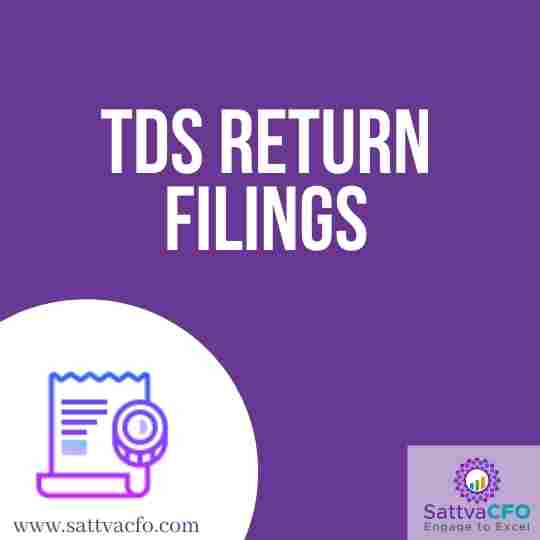TDS (Tax Deducted at Source) is a tax that is collected by the Indian government at the time of a transaction. In this scenario, the tax will be deducted when the funds are deposited to the payee’s account or when the payment is made, whichever comes first. tds return filing date, how to file tds return, tds return filing due date
What is TDS Return?
A deductor has to deposit the deducted TDS to the government, and the details of the same have to be filed in the form of a TDS return. A TDS return has to be filed quarterly, and failing to will incur a penalty.
Deductor is a person / legal entity who deducts Tax & remits the same to the Government by filing TDS returns.
Deductee is a person/legal entity from whom the tax is deducted.
Eligibility Criteria
Who can file TDS returns?
Organizations or employers that have obtained a valid tax collection and deduction number file TDS returns (TAN). Anyone making specified payments under the Income Tax Act is obligated to deduct taxes at the source and deposit the tax within the time limits for making subsequent payments.
- Payment of Wages
- Returns on investments
- Winning lotteries, puzzles, and other games can help you make money.
- Winnings from horse races, Insurance commissions
- Payments for the National Savings Scheme, among other things.
Details required for TDS returns filings.
- Name of the Entity (Proprietorship/ Partnership/ Company/ LLP)
- Date of Incorporation of the business
- TAN details
- PAN details
- No of Transaction for filing TDS returns
- Period for which TDS has to be filed
- Last TDS filing details, if any
Types of TDS Form
| Form Number | Purpose |
| Form 24Q | TDS from Salaries |
| Form 26Q | TDS on all payments apart from salaries |
| Form 27Q | Dividend, interest, or any other amount payable to non-residents |
| Form 27EQ | Collection of tax at source |
TDS Form 24Q
An employer deducts TDS from an employee’s wage in accordance with Section 192 of the Income Tax Act 1961. The Salary TDS returns must be filed on Form 24 Q, which must be submitted every quarter. In Form 24 Q, the details of the salary given to workers and the TDS deducted from the payment must be stated. To put it another way, Form 24 Q is a quarterly statement of the payment given to the employee and the TDS taken by the deductor.
TDS Form 26Q
In some situations, when a taxpayer pays taxes, the payee deducts TDS. TDS information on payments made other than wages is filed using Form 26Q. The Form shows the total amount paid in a given quarter and the amount of TDS that has been deducted. Every quarter, Form 26 Q must be submitted.
TDS Form 27Q
Form 27 Q is a TDS return or statement that specifies the Tax Deducted at Source on payments made to non-resident Indians and foreigners other than salaries. Every quarter, or before the due date, Form 27 Q must be submitted. The deductor sends Form 27 Q to the NRI with the information of the payments made and the TDS deducted on those payments.
TDS Form 27EQ
The information on Form 27 EQ is everything about the tax that is collected at the source. This form must be filed every quarter, according to Section 206 C of the Income Tax Act of 1961. Both corporate and government collectors and deductors are required to submit the Form.
TDS Return Due Date
The returns must be filed for every quarter, i.e., May 31, July 31, October 31, and January 31 for 2021-22.
| Quarter | Period | Last date of filing |
| 1st Quarter | 1st April to 30th June | 31st July |
| 2nd Quarter | 1st July to 30th September | 31st October |
| 3rd Quarter | 1st October to 31st December | 31st January |
| 4th Quarter | 1st January to 31st March | 31st May |
TDS return filing procedure
How to file TDS returns online?
- First, fill out Form 27 A, which contains many columns, and verify the physical copy of the Form together with the E-TDS return, which has been filed electronically.
- The tax deducted at the source and the total amount paid must be accurately filled out and totaled in the following step.
- On Form 27 A, the TAN of the organizations must be mentioned. If the TAN provided is wrong, the verification procedure will be complicated.
- The proper challan number, the manner of payment, and the tax details must be provided while filing TDS reports. There will be a discrepancy if the challan number or payment date is wrong, and the TDS returns will also need to be submitted afresh.
- The basic form used for filing the e-TDS must be utilized to ensure uniformity. To make the tallying procedure easier, the 7-digit BSR must be entered.
- TDS returns must be physically submitted to the TIN FC, which NSDL handles. In the event of an online filing, they can be submitted on the NSDL TIN’s official website.
- If the information given is correct, a token number or a provisional receipt is issued. This is evidence that a TDS return was filed.
- In the event of rejection, a non-acceptance memo is sent, along with the cause for the rejection, and the returns must be re-filed.
Pre-requisites for submission of Revised TDS returns
It is required to provide the TDS Certificate once the deductor has deducted the TDS. A valid TDS certificate from TRACES with a 7-digit unique certificate number and a TRACES watermark can be used to double-check the tax credit.
The deductee is required to keep the TDS certificates. TDS certificates for non-salary payments are issued every quarter, whereas TDS certificates for wages are granted once a year.
In the event that the deductee misplaces the certificate, he can seek a duplicate TDS Certificate.
Claiming TDS return
The deductor can claim TDS Credit. To claim the TDS credit, the deductee must include the TDS information in his income tax filings. When submitting income tax returns, the deductee must be careful to include the right TDS certificate number and TDS information.
There would be a difference with the tax credit for processing the TDS returns if the deductee provides erroneous information.
Late Filing Fees
Failure to file your returns within the due date will mean that you will be subject to a late filing fee of Rs.200 per day. The fee will be charged for every day after the due date until the date on which your return is filed. However, the maximum fees that you will have to pay will be limited to the TDS amount.
FAQ’s
What is TDS?
TDS (tax deducted at source) is a tax that the Indian government collects at the time of a transaction. In this scenario, the tax will be deducted when the funds are deposited to the payee’s account or when the payment is made, whichever comes first.
What is TDS Certificate?
It is required to provide the TDS Certificate once the deductor has deducted the TDS. A valid TDS certificate from TRACES with a 7-digit unique certificate number and a TRACES watermark can be used to double-check the tax credit.
The deductee is required to keep the TDS certificates. TDS certificates for non-salary payments are issued every quarter, whereas TDS certificates for wages are granted once a year.
In the event that the deductee misplaces the certificate, he can seek a duplicate TDS Certificate.
What is TAN?
The Tax Deduction and Collection Number, or TAN, is a ten-digit alpha number that must be obtained by anybody who is responsible for deducting or collecting tax at source on behalf of the government. Salaried persons are exempt from obtaining a TAN or deducting the tax at the source.
What is TDS return filing?
Tax deducted at source (TDS) is a method of minimizing tax evasion and leakage by requiring TDS payments at pre-defined rates.
Who is eligible for a TDS return?
Employers and organizations with a valid Tax Collection and Deduction Number file TDS returns (TAN). A person who makes certain payments as defined by the Income Tax Act is obligated to deduct tax at the source and deposit it within a certain time frame.
What is the concept of TDS?
To collect tax from the source of income, TDS was created. The deductor who is responsible for paying the deductee shall deduct the tax at the source and remit it to the central government’s account.
What happens if the TDS deducted is not deposited on time?
There is a penalty for failing to deposit or deduct TDS on time, and the employer might pay interest on such late TDS payments before filing TDS reports or responding to TRACES’ demand.
On what amount is TDS deducted?
TDS is deducted only if the whole income is taxable; if the total income is less than Rs 2,50,000, no TDS is deducted, and this figure applies to both males and women under the age of 60.
How is TDS calculated on salary?
First, calculate the exemptions available under Section 10 of the Income Tax Act (ITA), then subtract the exemptions found in step (2) from the gross monthly income calculated in step (1). Finally, multiply the number obtained from the above calculation by 12 because TDS is calculated on yearly income.
What is the duration required for a TDS refund?
It takes 30-45 days for the refund to be credited after the E-verification of the income tax return.
What is the penalty for delay in TDS payment?
If a person fails to file the TDS statement by the required date, a minimum penalty of Rs.10,000 is imposed, which can be increased to Rs.1,000,000.
Is it necessary to pay tax after TDS?
The majority of TDS payment rates are prescribed in the income tax legislation, and the payer deducts the TDS according to those rates. If you have given the employee investment evidence and the total taxable income is less than the tax limit, he will not have to pay any tax.
How long it takes to reflect the TDS in 26AS?
Depending on the effectiveness of the company’s accounting department, it takes 30-45 days to show the TDS deposit on Form 26AS.
Who issues the TDS Certificates?
The certificate of tax deduction at source, Form 16/16A, is provided on behalf of the employees when the employer deducts taxes. TDS / TCS information for various transactions between the deductor and the deductee is provided on these certificates. The TDS certificates must be provided to the taxpayers.
What is TDS reconciliation?
TDS Reconciliation Analysis and Correction Enabling System (TRACES) is an online platform run by the IRS that connects all parties engaged in implementing and managing Tax Deducted at Source and Tax Collected Source.
What are TDS and TCS?
The tax paid by sellers when they sell something to purchasers is known as TCS. TDS is the tax taken from a payment made to a firm if the amount exceeds specified thresholds. TCS deductions apply to sales of products such as lumber, scrap, mineral wood, and other such items.
What is Form 27A TDS?
Form 27 A is a summary of the e-TDS/TCS return (Forms 24Q.26Q,27Q, and 27EQ), which includes control totals for the amount paid, income tax deducted at source, and tax deposited at the source.
What is Form 26Q TDS?
Every quarter, Form 26 Q must be submitted.
How can SattvaCFO help us?
All you need to do is call us or email us for a hassle-free TDS Return Filings experience. tds return filing date, how to file tds return, tds return filing due date




